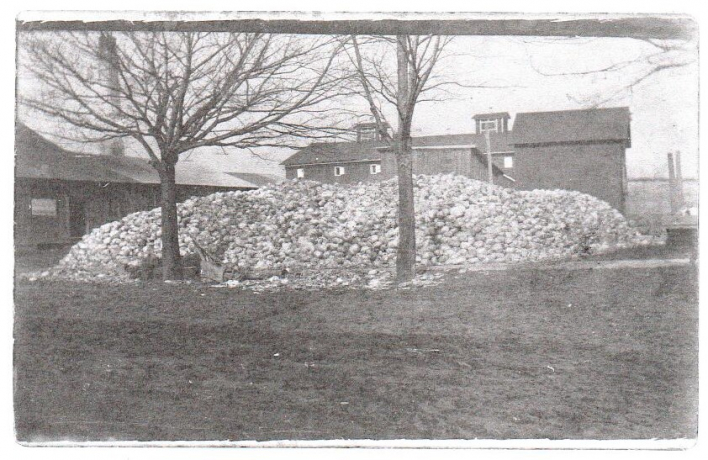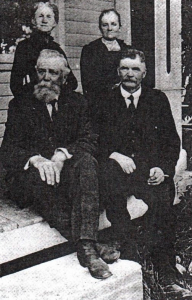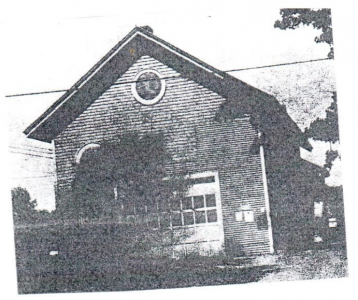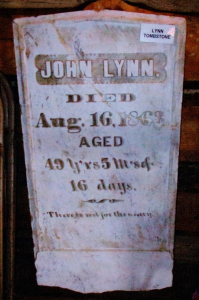Clay Sauerkraut HistoryPosted on January 21, 2021 |
Image

|
HISTORY MYSTERY: Clay Sauerkraut History
When Clay’s largest industry, the growing of tobacco and making of cigars fazed out, the farmers fazed into the production of milk for cheese and growing cabbage for sauerkraut. Pictured is the Ward Moulton Cannery for sauerkraut built in 1905 which joined the Weller Cannery on Route 31. The other photo is after a fire in 1932. Between these dates, Moulton was very successful. To make high-quality sauerkraut, they first sought help from Ohio State University through the Fremont Co., the nation’s second largest processor of sauerkraut. The trials examined which varieties performed best in terms of yield and quality. They compared 20 varieties from early-to late-maturing types. Criteria used were yield, head quality, maturity rates, color for kraut and impact of planting and harvesting time on quality. After all this testing, it was decided that the local soil variations made those trials of little use. Local farmers used Glory; it was well liked; and they were well paid for it.
In an average Season, the farmers delivered over 1,800 tons to the factory. When it arrived, it was chopped and put into vats, each one holding 43 tons. Mixed with the cabbage was 1,400 pounds of salt for each vat. This is allowed to stand for 21 days before it is edible for kraut eaters, and 45 days for canning. This is preheated, canned and run into the “exhaust box,” where the heat is raised to 212 degrees Fahrenheit and where the kraut remains for 12 minutes. Next operation is placing the covers on the cans and then they go into the cooling room where they remain for 24 hours. They are labeled, placed in boxes and shipped out.
A personal memory of the process was given to me years ago by Oliver Hughson of when he worked at Weller Canning as a young man. “Between three and five tons of cabbage was processed and distributed all over the country each year with either the company’s Snow Floss brand label or local labels as Loblaws. Cutting of the cabbage began August 1 and continued through early November. I remember forking the cut cabbage into 12-foot diameter vats for processing. Fermentation took from four to six weeks. The cans were filled by hand starting in mid September and ending in February, although other plants had become automated. To the very last, they supplied local markets and restaurants.”
“The 1932 fire totally destroyed both factories and canneries. The plants main buildings were wooden with small brick additions. Harrison Bonsted, manager of the Weller Plant, discovered the fire. Companies arrived from Central Square, Brewerton and Cicero to assist Clay. The coal yard and feed mill property of frank Sotherden of Clay was saved by firemen even though only four feet away from one of the burning buildings. A slight wind carried the flames away from the burning buildings and….saved the Mill.”
By 1942, the only industry left in Clay was the Weller Company. Lemuel Ladd was the manager of this sauerkraut processing and canning industry. He was also Justice of the Town of Clay. It had been rebuilt after the 1932 fire, but disaster struck once again in 1942. Because of the war, materials were impossible to obtain and it wasn’t until 1946 when the building was reconstructed of cinder blocks. Again in 1956, it was gutted by fire. It was rebuilt and purchased by the Fremont Kraut Company of Ohio. Harry Crowell became the Clay plant manager in 1973.
Around March 1, 1977, he received a startling edict from the parent company that “local operations were to be halted by June 1 or thereabouts.” They were going to have to comply with strict regulations imposed by the State Department of Environmental Conservation. New equipment would have to be installed to discharge and eliminate cleanup water used in the sauerkraut process cleanup. The parent company did not feel it was cost effective. The local farmers who had depended on this added income would have to find a new market or switch to a new crop to grow!
Dorothy Heller, Historian
1-20-21
Other
History Mysteries

Australian's Visit Town of Clay
History Mystery | Dec 14, 2015
REMEMBERING CLAY
Australians visit great great-grandfather’s homestead



